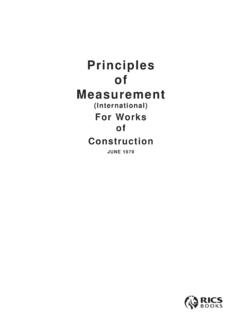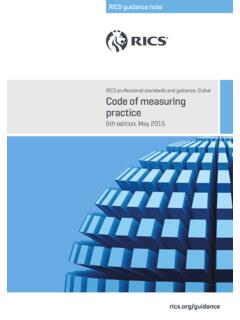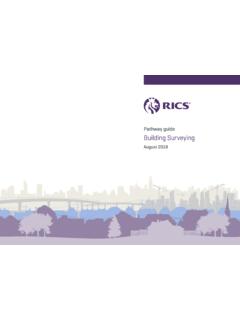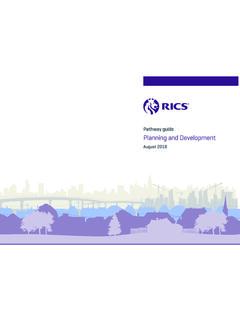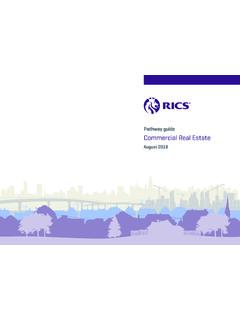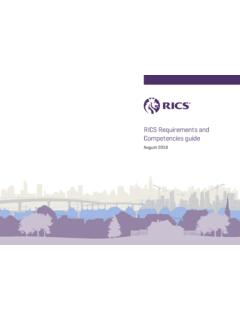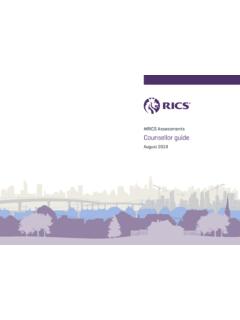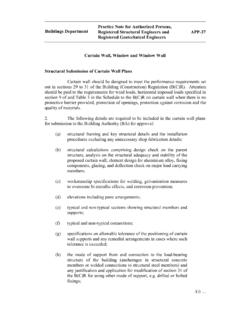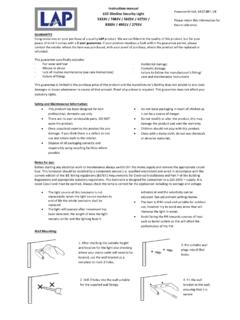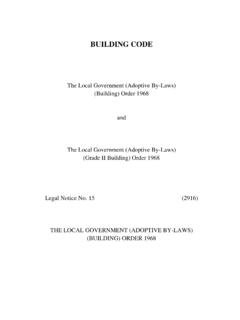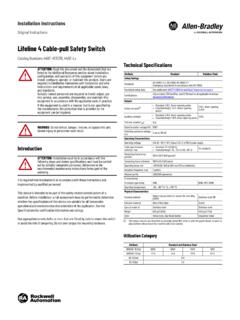Transcription of Valuation of properties in multi-storey, multi-occupancy ...
1 Valuation of properties in multi-storey, multi-occupancy residential buildings with claddingGUIDANCE NOTEUK1st edition, March 2021 Valuation OF properties IN MULTI-STOREY, multi-occupancy RESIDENTIAL BUILDINGS WITH CLADDINGRICS guidance note, UK1st edition, March 2021 Effective from 5 April 2021 Published by the Royal Institution of Chartered Surveyors (RICS) Parliament SquareLondonSW1P 3AD No responsibility for loss or damage caused to any person acting or refraining from action as a result of the material included in this publication can be accepted by the authors or 978 1 78321 414 3 Royal Institution of Chartered Surveyors (RICS) March 2021. Copyright in all or part of this publication rests with RICS.
2 Save where and to the extent expressly permitted within this document, no part of this work may be reproduced or used in any form or by any means including graphic, electronic, or mechanical, including photocopying, recording, taping or web distribution, without the written permission of RICS or in line with the rules of an existing effort has been made to contact the copyright holders of the material contained herein. Any copyright queries, please get in touch via the contact details professional standards and guidance 1 RICS guidance notes 1 Glossary 31 Introduction Purpose Effective date Current UK government guidance RICS Valuation standards Valuation standards and the consolidated advice note 52 The EWS1 form Criteria where an
3 EWS1 should be required 73 Risk and liability 9 Appendix A: Case studies 11A1 Case study 1 11A2 Case study 2 12A3 Case study 3 13A4 Case study 4 14A5 Case study 5 15A6 Case study 6 16A7 Case study 7
4 17A8 Case study 8 18A9 Case study 9 19 Appendix B: EWS1 form decision tree 20 Appendix C: Application of RICS Valuation Global Standards and UK national supplement to the Valuation of properties in multi-storey, multi-occupancy residential buildings with cladding 21C1 General 21C2 UK Residential Mortgage Valuation 22C3 Assumptions 22C4 Reporting 23 IPiiVALUATION OF properties IN MULTI-STOREY.
5 multi-occupancy RESIDENTIAL BUILDINGS WITH CLADDINGRICS professional standards and guidanceRICS guidance notesDefinition and scopeRICS guidance notes set out good practice for RICS members and for firms that are regulated by RICS. An RICS guidance note is a professional or personal standard for the purposes of RICS Rules of Conduct. guidance notes constitute areas of professional, behavioural competence and/or good practice. RICS recognises that there may be exceptional circumstances in which it is appropriate for a member to depart from these provisions in such situations RICS may require the member to justify their decisions and of these provisions in legal or disciplinary proceedingsIn regulatory or disciplinary proceedings, RICS will take account of relevant guidance notes in deciding whether a member acted professionally, appropriately and with reasonable competence.
6 It is also likely that during any legal proceedings a judge, adjudicator or equivalent will take RICS guidance notes into recognises that there may be legislative requirements or regional, national or international standards that take precedence over an RICS guidance liability is accepted by RICS to any third party for reliance on this guidance in matters of life safety, nor for any liability that may arise as a result of any party using this guidance note to decide whether an EWS1 form is requiredIP1 Valuation OF properties IN MULTI-STOREY, multi-occupancy RESIDENTIAL BUILDINGS WITH CLADDINGD ocument status definedThe following table shows the categories of RICS professional content and their statusType of documentDefinitionRICS Rules of Conduct for Members and RICS Rules of Conduct for FirmsThese Rules set out the standards of professional conduct and practice expected of members and firms registered for regulation by standardHigh-level standard developed in collaboration with other relevant professional statement (PS)Mandatory requirements for RICS members and RICS regulated guidance note (GN)
7 A document that provides users with recommendations or an approach for accepted good practice as followed by competent and conscientious code of practice (CoP)A document developed in collaboration with other professional bodies and stakeholders that will have the status of a professional statement or guidance jurisdiction guide (JG)This provides relevant local market information associated with an RICS international standard or RICS professional statement. This will include local legislation, associations and professional bodies as well as any other useful information that will help a user understand the local requirements connected with the standard or statement.
8 This is not guidance or best practice material, but rather information to support adoption and implementation of the standard or statement OF properties IN MULTI-STOREY, multi-occupancy RESIDENTIAL BUILDINGS WITH CLADDINGG lossaryCladding (for the purposes of Valuation only)A method of enclosing a building externally by the attachment of finishing materials spanning between given points of support on the face of the building. For the purposes of this guidance note, the material types together with their fixings to be considered as cladding are: aluminium composite material (ACM) brick slips high pressure laminate (HPL) metal composite material (MCM) metal sheet panels rendered external wall insulation system plastic tiling systems and : this list of cladding types is as defined by the UK government in Building Safety Programme: estimates of EWS1 requirements on residential buildings in wall glazingAn external wall cladding type comprising a frame or grid fixed to the face of a structure, usually at floor levels, with glass infill panels, with or without spandrel panels.
9 StoreyA storey is any floor or part of a floor of a building visible above ground level, including the ground floor, whether used for residential, commercial, parking or other use. It does not include basements or mezzanine levels. Where a building has multiple levels, the highest number of floors in the building should be used for applying the the purposes of this document, and for consistency with the Advice for Building Owners of Multi-storey, Multi-occupied Residential Buildings, the following external wall types have been excluded from the term cladding : masonry construction (panels of solid brickwork, blockwork, or stonework) traditional cavity wall construction (with a brickwork, blockwork or stonework external leaf) timber framed buildings (with a brickwork, blockwork or stonework external leaf) concrete panels and stone panels.
10 IP3 Valuation OF properties IN MULTI-STOREY, multi-occupancy RESIDENTIAL BUILDINGS WITH CLADDING1 Purpose This document is intended to help valuers undertaking valuations for secured lending purposes on domestic residential blocks of flats in the UK only, but may also be useful when undertaking valuations of such properties for other purposes. It does not apply to individual terraced, semi-detached or detached houses, bungalows or developments considered to be non-domestic. Following consultation with the fire safety industry, insurers and lenders, it provides criteria that can be used by a competent valuer during a standard Valuation inspection to identify buildings where remediation work to cladding for fire safety purposes that may materially affect the value of the property is likely to be required.
